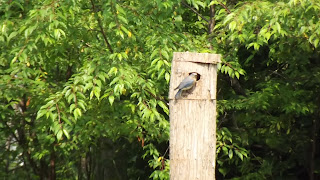In this one we will use secondary food products: peelings, plant leftovers, egg shells, coffee grounds, rinds. At a pound a day times 365 days, the nitrogen factor should be solved even if most of the material, dead leaves are carbon. Cut and drive in 4'- 2"x4" stakes leaving 2' above grade:
Wife says OK but make it pretty.
Added 2' high wire fencing and at the base of the perimeter, 6" planks of old fence planks to I can keep the perimeter trimmed
Inspired by Hugelkultur, the first layer was thicker wood branches, directly on the soil
Next began layering with other second harvest material: leaves, trimming, discarded plant material from the neighborhood.
Final step is to fill it up with second harvest material this week and let it cook down over the winter until spring planting if enough of the organics have broke down by then.
Aviaticus Clouds are forming in the encroaching boundary sheet, rain on the way so the moisture will accelerated the decomposition.
I expect the structure to last at least 20 years and if ever abandoned the soil will be left improved.
We daily had added lots of organic material, potato peelings, egg shells, coffee grounds.... After cooking down a couple months I added another layer before the snow:
First a load of cardboard from a local company, the cardboard may suppress unwanted plant growth:
Then I intercepted another load of wet leaves from the neighborhood that was destined for the landfill:
The rest of the winter we will continue to top this off with organic materials.













































.jpg)






